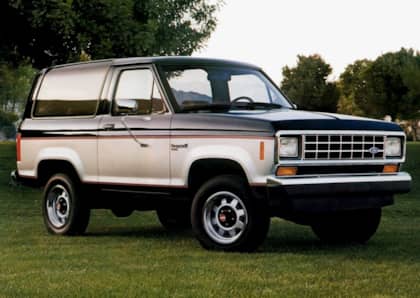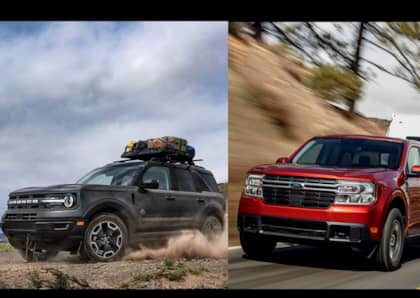Ford Centurion Conversions Gave Us The F-150-based 4-Door Bronco SUV The Factory Never Did
For decades General Motors dominated the full-size sport-utility vehicle scene with the Chevrolet Suburban and its GMC clone. No other truck builder offered the same kind of 7 passenger SUV, with three rows of bench seats expanding that capacity to a hefty 9 passengers in certain models.

With rival Ford on the outside looking in until the development of the Expedition in the late 1990s, a few enterprising aftermarket companies did their best to appeal to fans of the brand by building unique extended-wheelbase sport-utility vehicles of their own using Blue Oval bones. Of these, by far the most successful was Centurion which offered an entire range of 'what might have been' SUV conversions that combined the best elements of the Ford F-Series and the Ford Bronco, in effect creating the very first four-door version of the latter decades before Dearborn would think to do the same.

Almost Like Lego
For conversion companies it doesn't get much better than starting off with full-size pickups like the Ford F-150 or Ford F-350 that were used as the foundations for Centurion builds. Gifted with a strong ladder frame and relatively simple body lines, it was relatively easy for the company's design team to take the Bronco's hindquarters and mate them to the front end of either version of Ford's strong-selling pickup truck.

The process itself was fairly simple. Given that the Bronco was built on a short-wheelbase version of the F-150, all Centurion had to do from a design standpoint was use a four-door chassis cab version of the platform and graft the Bronco's rear passenger compartment on top of where the bed typically would be. This meant that, at least in their initial run, Centurion Classic 50 and Classic 350 (for full-ton conversions) featured the same lift-off fiberglass roof at the back as their smaller Bronco cousins.
Of course, there were a number of finishing touches required to give the Ford Centurion a factory-like look. Inside, most models offered 9-passenger seating by maintaining the stock Bronco bench at the back, although it was of course possible to select captain's chairs for the middle row as well as the first two positions. The company also made sure to fill each model with as many luxury features as possible, in order to help justify the high prices charged for the conversion (with window stickers that would have approached $70k in adjusted dollars). This included items like TVs, VCRs, and surprisingly a cooled storage compartment suitable for hauling temperature sensitive snacks and beverages.

The exterior of the trucks remained almost entirely factory-look, although as time went on from their late-80s debut, Centurion would eventually replace the Bronco's fiberglass components with more durable steel. This would also mean the end of lift-off convertible fun for anyone purchasing the 4x4 SUV.
Mucho Motor, Mucho Towing
The Ford Centurion had one big ace in the hole that GM simply couldn't match: the existence of the full-ton C-350 model. Although Chevrolet sold a three-quarter ton version of the Suburban, a full-ton never left the factory before the year 2015.

This oversight allowed Centurion to fill a very specific market niche among those who required three rows of passenger room plus massive towing capacity. The Classic 350 offered up to 10,000 lbs of towing capacity, which it could do much more comfortably than the Suburban 2500 of the time. The C-350 was also nearly 9 inches longer than the Suburban, which gave it a stability advantage as well as additional cargo space to go with its hefty tow rating.

Under the hood, the C-150 offered the choice between a 5.0-liter V8 (185-205 hp, 270-275 lb-ft of torque), or a 5.8-liter V8 (210-240 hp, 305-310 lb-ft of torque). The larger C-350 stepped up to either Ford's monster 7.5-liter mill (225-245 hp, 362-410 lb-ft of torque), or a 7.3-liter diesel V8 that was good for up to 215 horsepower and 425 lb-ft of torque.
Felled By Expedition
Although Centurion had been converting E-Series vans since the early '80s (typically adding a dual rear wheel setup to improve towing capacity), it didn't get into the four-door Bronco business until the 1987 model year. It would continue to build its unique F-Series SUVs for almost a decade, only being forced to stop when Ford discontinued production of the Bronco after 1996.

In a way, it was a natural coda for Centurion. The following year Ford would introduce the Expedition, which would finally put the brand in the three-row SUV game using the same F-150 backbone that the aftermarket company had relied on. There were some significant differences, of course, including the Expedition's nearly two-foot reduction in overall length, plus the lack of a full-ton or even three-quarter ton model (which would eventually be remedied by the introduction of the Excursion in the year 2000).
Still, with demand for four-door high capacity haulers now satisfied by the Ford mothership, Centurion's conversion business would gradually fade away as its flow of tow-focused customers wasn't high enough to convince the company to cannibalize used Bronco bodies and older F-350 chassis to continue building its SUVs piecemeal.

By 2006, Centurion would join forces with one of its custom truck rivals, Southern Comfort Conversions, ending a unique chapter in truck history that is remembered only occasionally when one of its Classic 150 or Classic 350 vehicles goes up for sale on Craigslist.
Curious about the history of the Suburban? We hook you up with the details on the Chevrolet SUV's greatest generation.











